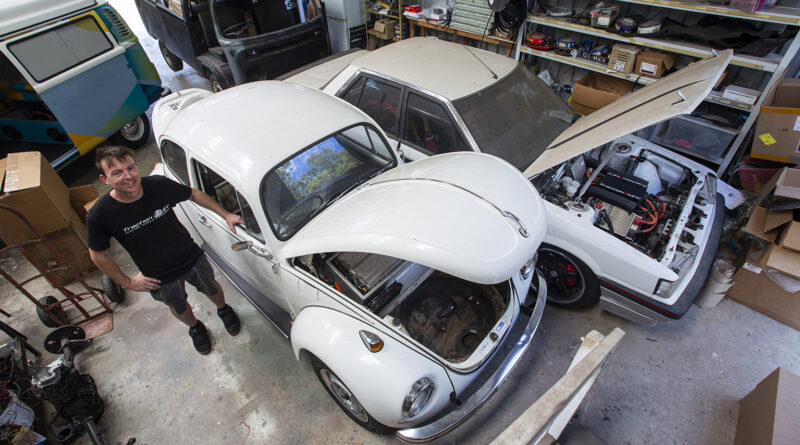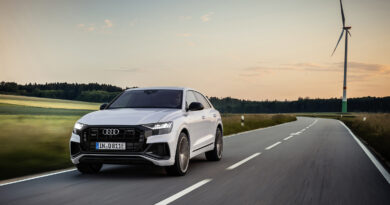Traction EV – converting classic cars to electric
As the bright blue 1968 VW Beetle pulls away, the ghostly silence is almost deafening. Where’s that distinctive air-cooled beat? Why can’t I hear that familiar rattle I’ve associated with Volksies since I was in nappies?
The answer is electric. James Pauly, founder of Queensland’s Traction EV, has gone to work converting this air-cooled classic into a battery-powered street-legal racer.
Want the latest EV news and reviews delivered to your inbox? Subscribe to our weekly newsletter!
NetGain Motors in the US has provided an 88kW HyPer 9 electric motor; a 28kWh Tesla battery pack brings the juice, and this curvaceous VW now goes far quicker than it ever did in its petrol-powered life. All-electric range? Over 150 kilometres.

“We’re future-proofing vehicles,” James explained. “The number one thing is don’t hurt the car. I go to a lot of classic car shows with the Beetle and I hear murmurs in the crowd: ‘how could you do that?’ but there’s no cut, no weld. It’s all totally reversible, which is a lot less than many engine swaps.”
During my visit to James’ workshop north of Brisbane he received a delivery from the US containing eight electric motors. “They’re the newest HyPer 9 motor NetGain makes,” he said.
“They’re compact, nine-inches in diameter, relatively light and ideal for a small car weighing around a tonne. They make 90kW and 240Nm torque, so are a lot of fun in a light car.” Six motors are destined for customers around Australia, the other two for forthcoming builds at Traction EV.
Classics big and small
A hoist at James’ workshop holds a Land Rover Defender ready for its new electric heart; there’s a pair of electrified VW Kombis, a Beetle with battery pack housed under its bonnet, and a second-generation Mazda MX-5 with the same 88kW HyPer 9 motor found in James’ company demonstrator Beetle.

Just quietly, something of an EV conversion mini revolution is happening in South East Queensland. Just down the road, Brisbane’s Charged Garage is working on an electric conversion classic car share program, and enlisted Traction EV to convert its beautifully restored 1965 Ford Cortina Mk1.
It features an 88kW/236Nm NetGain HyPer 9 motor (about twice that of a Cortina’s original 1.5-litre engine) and five Tesla Model S battery modules, making a total of 28kWh and allowing a 150km range.
There’s an onboard AC charger that can deliver 3.3kW for wall socket charging, while Traction EV fitted a DC fast charge system so 80 percent charge is possible in 30 minutes through a CHAdeMO plug.
So how did this all start? James spent his formative years in a more traditional manner: hotting up a Holden Gemini panel van and then a Hemi-powered Chrysler Centura, cutting his mechanical teeth along the way.
“I watched the documentary film Who Killed the Electric Car? in about 2007 and thought ‘what the hell’s going on here?’” he said. “I got into electric radio-controlled car racing and that taught me a lot about lithium battery technology, safe charging procedures and electric motor theory. RC cars are just in a scaled-down package, so I thought I could apply my mechanical knowledge and start building EVs.”
James discovered hero EVs through the internet, including the White Zombie 1972 Datsun 1200 which was once the world’s fastest street-legal electric car and, in California, EV West’s Tesla-motored 800hp BMW M3 Pikes Peak racer.
A new Australian business
Inspired, he began his first conversion on a 1987 Nissan R31 Skyline using two 300kW NetGain’s Warp11 DC motors. Then, after a chance Facebook post, he lucked into interning at EV West for two months.
“I learned how to design motor adapter plates and battery boxes, which are the two most critical and difficult things to build for a car,” he said. “I was offered a job there, but I had the dream to start a business in Australia as nobody was really pushing ahead in a big way.”

The business established, his first client needed help finishing a 1964 VW Beetle being converted with electric parts from EV West. James soon saw the potential for converting VWs.
“They’re so popular in Australia for engine swaps, are lightweight, mechanically very simple and very easy to pass mechanical inspection. I thought I’d better build my own to have as a demonstrator here at all times.”
The company’s VW conversion kits give the buyer plenty of choice. An HPEVS AC-50 motor brings 52kW/163Nm, or you can fit two of these for 104kW/326Nm. The HyPer 9 alternative has 88kW/236Nm, or you can double up again and score a mighty 176kW/472Nm … if you’re feeling bonkers.

Air-cooled VWs are James’ preference as his kits are now off-the-shelf. “I don’t have to put any extra design hours in,” he said. As for price, depending on different charging options, you’re looking at around $30,000. “Not counting any restoration,” James stipulated. “I don’t do bodywork, just the conversion.”
Your money buys about 90kW of power, 160km electric range and an overnight charger. A DC fast charger option (the CHAdeMO charge port used by the Nissan Leaf) adds a few thousand more.
Choosing your classic
So what other classics are best suited to electric swaps? Nothing running CAN bus electronics (anything post-1990s, basically), James said.
“They’re just too complex software-wise to bother with, but it’d be great to have someone onboard who was a CAN bus aficionado who wants to hack, then we could convert more modern stuff.” Classics, for now, are ideal.

“People bring me ideas of all different types of vehicle, but unfortunately some aren’t suitable,” James said. “Certain body shapes are better than others.”
Classic Minis are a bit too small, while station wagons and panel vans are difficult due to the battery box needing to be in the back, eating into rear space. Sedans are better as batteries go under the parcel shelf, while utes are good as there’s spare space under the tray to hide batteries.
Sitting forlornly outside the workshop is a Tesla Model X’s stripped shell, harvested for its coveted parts. The NetGain motors serve their purpose, but Tesla motors and batteries are hot property, but Tesla won’t sell you them direct.

The crashed Model X cost over $30,000 at auction, and the winning bidder was counting on the motor and batteries being sound.
“The battery packs are pretty tough; there’s lots of structure around them,” James said. “The Kombi I’m working on has only the small drive unit from Tesla, but that’ll give about 225kW, while 14 of the 16 modules from Tesla’s battery pack will give about 350km range.” That’s going to be one rapid old bus.
Ideal racing cars?
As an increasing number of drivers appreciate the potential of EVs as racing cars, James is on board with his 1987 Nissan R31 “The Shocker” Skyline. He’s installed dual NetGain Warp11 motors to offer 600kW, while the 50kWh Tesla battery allows a potential range of some 200km, when used sensibly.
Still street legal but aimed squarely at the track, it features plenty of go-fast bits from the modified Japanese tuning scene, including suspension from an S13 Silvia, an R33 GTS-T brakes, LSD, roll cage and much-needed wide sticky tyres.

A custom two-speed Powerglide transmission – typically found behind big block V8 drag cars – does the shifting as most manual gearboxes simply couldn’t handle this much power.
“The Warp 11’s a DC brushed motor with instantaneous torque, even compared to AC motors,” said James. “I wouldn’t recommend them for a daily driver, but they’re great for drag racing.”
Keeping classics alive
Right now there are no official qualifications required for the work James is doing, though he’s keen for that to change in future. “I don’t install suspension or brakes, I’m not touching the safety side of things,” he said.
While purists are quick to grumble about the internal combustion beating heart being torn from these classic bodies, James puts up a solid argument for the importance of his work in actually potentially saving these old cars.
“It’s keeping them running, keeping them on the road,” he explained. “I had a customer say he wanted to convert to electric so he could use his classic more on weekends.

“I say not just weekends; you’re turning it into the ultimate daily driver. You can rack up the kilometres Monday to Friday and it’s bulletproof reliable. You’re not putting kilometres on an old engine.”






James took me for a spin in his blue bottle when I dropped in on him making some enquiries. It definitely gets up and goes
James is a Top Gun when it comes to converting almost any classic car to EV. The white 1971 Beetle in the photograph has been completed by James. However, my frustration is the fact that Covid19 has “stranded” me over in the UK, for over 200 days now. I cannot see (or drive) my beloved electric Beetle! Finally, I am very proud to be associated with Traction EV, and the care taken of my Beetle EV conversion.